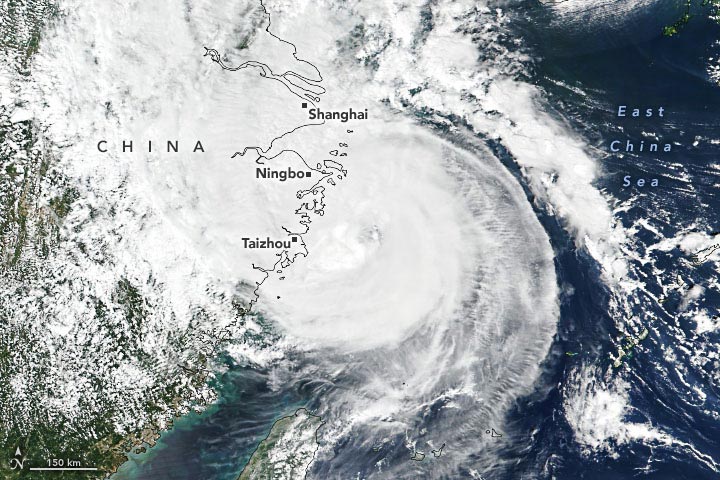
Typhoon Muifa made landfall twice near China’s largest metropolitan area and several of the world’s major shipping ports on September 14, 2022. First, the typhoon crossed over land at Zhoushan Island, then it passed over Hangzhou Bay, and it eventually came ashore in Shanghai.
According to news reports, it is the strongest storm to reach the Yangtze River Delta since Typhoon Damrey in 2012. It is estimated that 230 million people live on and around the delta. In the major ports of Ningbo and Shanghai, operations were suspended. Likewise, oil and gas operations were halted on Zhoushan. In addition, ferry and shipping traffic were suspended, fishing boats were called into port, and flights to and from the region were canceled. China’s Xinhua news agency reported that more than 1.3 million people were relocated from Zhoushan before the arrival of the storm.
On September 14, 2022, just after 1 p.m. local time, the Visible Infrared Imaging Radiometer Suite (VIIRS) on the Suomi-NPP satellite acquired this natural-color image of Muifa as it was approaching southeastern China. On September 14 at 10:15 p.m. (14:15 Universal Time), the U.S. Joint Typhoon Warning Center reported that the center of the storm had moved offshore of Zhoushan and was about 90 miles (150 kilometers) south-southeast of Shanghai. Muifa had sustained winds of 80 knots (90 miles per hour/150 kilometers per hour), with gusts up to 100 knots (115 miles per hour/185 kilometers per hour) at that time.
Earlier this week, Typhoon Muifa battered Japan’s Ryukyu Islands. These had already been damaged by Typhoon Hinnamnor just a week earlier. Taiwan was also drenched by outer bands of Muifa as it passed.
Although the Western Pacific typhoon season stretches across the entire year, the majority of storms usually form between May and October. So far in 2022, 16 tropical storms have formed in the basin. Six of these have become typhoons. As of September 13, sea surface temperatures were quite warm in the Western Pacific, providing fuel for tropical cyclones. However, the surface waters off of southeastern China were relatively cooler because the passage of Hinnamnor had caused water to well up from the depths. That may have prevented Muifa from intensifying even more.
NASA Earth Observatory image by Joshua Stevens, using VIIRS data from NASA EOSDIS LANCE, GIBS/Worldview, and the Suomi National Polar-orbiting Partnership.
Never miss a breakthrough: Join the SciTechDaily newsletter.